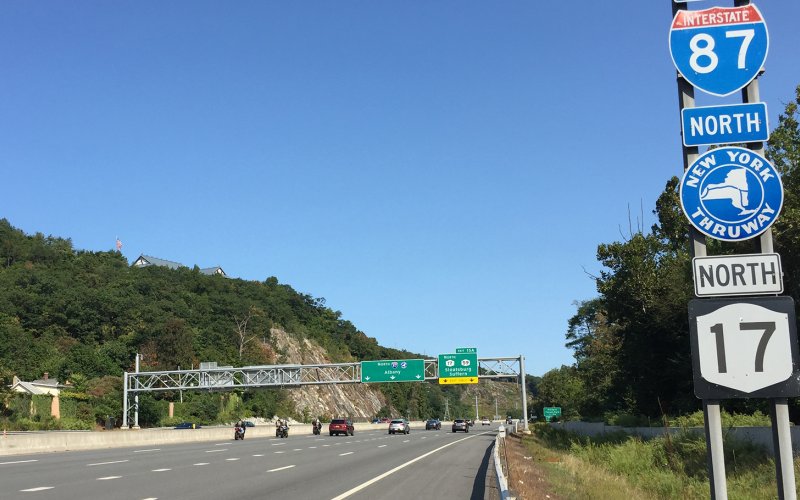5 Questions With Jerry Miller

ALBANY, N.Y. (Oct. 21, 2021) – Established in 1978 at the request of the New York State Department of Motor Vehicles and Governor’s Traffic Safety Committee, UAlbany’s Institute for Traffic Safety Management and Research (ITSMR) conducts traffic safety research and offers a variety of services to local, state and national agencies and organizations seeking to reduce motor vehicle crashes, fatalities and injuries.
On July 1, Gerard “Jerry” Miller assumed leadership of the Institute, with the task of continuing to adapt ITSMR research to meet the evolving challenges facing the community at large, including the legalization of marijuana on traffic safety on driving in New York.
Miller first joined ITSMR in 2016 as a project director and has been instrumental in expanding the Institute’s capabilities in the area of drugs and driving. Prior to ITSMR, he worked for New York for 15 years in various capacities, including serving as a program representative for the Governor’s Traffic Safety Committee where he also held the position of state coordinator for New York’s Drug Recognition Experts (DRE) program. He began his professional career as a police officer in 1993 in Pittsfield, Mass., and has a master’s degree in public aAdministration from the Rockefeller College of Public Affairs and Policy.
Why was the Institute for Traffic Safety Management and Research started and how has it helped improve traffic safety in New York?
ITSMR was established in 1978 to provide a link between the State University of New York and New York state government to provide a mechanism for integrating academic expertise and resources into efforts to prevent motor vehicle crashes and reduce fatalities and injuries on the state’s roadways.
The Institute’s primary functions are conducting research on the causes and contributing factors to motor vehicle crashes and designing evaluation studies to assess the effectiveness of programmatic and legislative initiatives to reduce crashes and the severity of injuries suffered. In addition, the Institute provides a variety of services related to highway safety concerns of the member agencies of the Governor’s Traffic Safety Committee (GTSC), the State Legislature, local governments, county traffic safety boards and other highway safety organizations.
These services include consultation in areas of highway safety policy, strategic planning, and traffic records systems; information services; technical assistance in research design and methodology, survey design, data analysis and program evaluation; training; and group facilitation and organizational support services. New York has led the nation in the implementation of major initiatives to improve highway safety, including passin of the nation’s first seat belt law and establishin the renowned STOP-DWI program, a self-sustaining statewide program to curb drinking and driving.
ITSMR has adapted to technological advancements over the years in two prominent areas: the Traffic Safety Statistical Repository and the Drug Recognition Expert Data Entry & Management System. Both of these tools provide in-depth information and data analyses in the areas of crash and ticket data, as well as drug-impaired driving.
The DRE Data System has been so successful in New York that the University has licensed the software and it has now been implemented in 12 additional states.
What are some of the changes you've seen in your three decades in traffic safety?
Technology has been one of the greatest changes in terms of both challenges and opportunities. Information is now at the fingertips of everyone from the police office on the street, the dispatcher behind the radio, the analyst generating reports, and the policy makers evaluating the effectiveness of programs. The elimination of paper and the transformation to electronic records has opened a world of opportunities.

In addition, the use of technology by auto makers has certainly improved the safety of our roads. Lane departure warnings, self-dimming headlights, blind spot monitoring, ignition interlock devices, airbags, crash alerts and 911 notifications, alcohol detection systems, and self-driving vehicles have all contributed to safer roadways. Technology has the potential to correct for human error in ways that traditional behavior modification methods cannot. However, technology comes with its challenges.
In addition to technological changes, I have seen a tremendous shift in driver behavior and attitudes in regard to drinking and driving. Over the past 30 years there has been real success in the messaging that drinking and driving is not acceptable, and crashes have dropped significantly as a result. The ease of arranging a ride today via a cell phone and the popularity of ride share companies have made a tremendous impact. Unfortunately, much work is still ahead of us in regard to getting that same message delivered for drug impaired drivers.
What are some of the current research projects at ITSMR?
Drug Impaired driving will be a major area of interest for ITSMR in the coming years. The GTSC funded the development of the DRE Data Entry & Management System in 2014. Through the DRE System, Drug Recognition Experts collect data during the evaluation of a suspected drug impaired driver. The data is transmitted to a statewide database maintained by ITSMR. Through grant funding sponsored by GTSC, ITSMR will conduct research and analysis to assist with legislative and policy initiatives as well as make recommendations for the overall improvement of the Drug Recognition program nationwide.
Effective March 31, New York State enacted legislation legalizing adult-use cannabis. To help determine the eventual effect of this legislation on traffic safety, the GTSC recently funded ITSMR to conduct a study that examined the pre-law data with regard to drivers found to be driving with cannabis in their system. The findings should provide valuable information to New York’s traffic safety community, especially the state’s Advisory Council on Impaired Driving and the GTSC, for developing effective enforcement and public awareness strategies to address the problem of drug-impaired driving among motorists in New York State.
How did your experience as a police officer impact your career?
My experience as a police officer is one that I will always cherish. I learned a tremendous amount during my eight years in uniform. The career of a police officer is incredibly unique, challenging and rewarding. Many of those experiences translated to lessons that I have carried with me in my professional career and have translated into life-long lessons.
I did not experience a pivotal event in my law enforcement career that moved me into the arena of traffic safety but rather I developed a deep appreciation over time for the critical need for information and data to better improve the decisions being made by police officers as well as the policies being implemented by administrators and legislators.
Law enforcement officers need timely and accurate data, and they need the technological tools to stay ahead of an ever-changing environment. Administrators need information at their fingertips to make critical decisions and to direct resources. Legislators need the support of research and data in order to implement effective laws. I have had the great fortune over the past 20 years to be involved in some wonderful projects that I believe have contributed to better policing and safer communities.
What’s on your reading table at home?
My wife and I both love to read. Our three daughters are grown and have homes of their own which affords us time for reading, and our coffee table is home to a wide genre of books. I used to enjoy fiction and mysteries, but now I gravitate toward historical books and autobiographies, and books about hiking, running, and fitness (both physical and mental).
Books that I have recently read include:
- Together: Why Social Connection Holds the Key to Better Health, Higher Performance, and Greater Happiness
- Facing the Mountain: A True Story of Japanese American Heroes in World War II
- Where’s The Next Shelter? An Appalachian Trail Through Hike
- Born a Crime: Stories From a South African Childhood
- 26 Marathons: What I’ve Learned About Faith, Identity, Running and Life
- His Truth is Marching On: John Lewis and the Power of Hope
- American Dirt
- The Waters Between Us
- The Incomplete Book of Running
- The Splendid and the Vile: A Saga of Churchill, Family & Defiance During the Blitz




